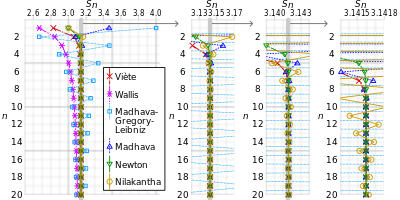Wallis product
In mathematics, Wallis' product for π, written down in 1655 by John Wallis, states that

Derivation
Wallis derived this infinite product as it is done in calculus books today, by examining for even and odd values of n, and noting that for large n, increasing n by 1 results in a change that becomes ever smaller as n increases. Since modern infinitesimal calculus did not yet exist then, and the mathematical analysis of the time was inadequate to discuss the convergence issues, this was a hard piece of research, and tentative as well.
Wallis' product is, in retrospect, an easy corollary of the later Euler formula for the sine function. In 2015 researchers C. R. Hagen and Tamar Friedmann, in a surprise discovery, found the same formula in quantum mechanical calculations of the energy levels of a hydrogen atom.[1][2][3][4][5]
Proof using Euler's infinite product for the sine function[6]
Let x = π/2:
Proof using integration[7]
Let:
(a form of Wallis' integrals). Integrate by parts:
This result will be used below:
Repeating the process,
Repeating the process,
- , from above results.
By the squeeze theorem,
Relation to Stirling's approximation
Stirling's approximation for n! asserts that
- .
Consider now the finite approximations to the Wallis product, obtained by taking the first k terms in the product:
pk can be written as
Substituting Stirling's approximation in this expression (both for k! and (2k)!) one can deduce (after a short calculation) that pk converges to π⁄2 as k → ∞.
ζ'(0)[6]
The Riemann zeta function and the Dirichlet eta function can be defined:
Applying an Euler transform to the latter series, the following is obtained:
See also
- John Wallis, English mathematician who is given partial credit for the development of infinitesimal calculus and pi.
- Viète's formula, a different infinite product formula for π.
- Leibniz formula for π, an infinite sum that can be converted into an infinite Euler product for π.
- Wallis sieve
Notes
- ↑ Friedmann, Tamar; Hagen, C. R. (2015). "Quantum mechanical derivation of the Wallis formula for π". Journal of Mathematical Physics. 56: 112101. arXiv:1510.07813. Bibcode:2015JMP....56k2101F. doi:10.1063/1.4930800.
- ↑ "Discovery of classic pi formula a 'cunning piece of magic'." University of Rochester (November 10, 2015
- ↑ "New derivation of pi links quantum physics and pure math." American Institute of Physics (November 10, 2015)
- ↑ "New derivation of pi links quantum physics and pure math." Phys.org (November 10, 2015)
- ↑ "Revealing the hidden connection between pi and Bohr's hydrogen model." Physics World (November 17, 2015)
- 1 2 "Wallis Formula".
- ↑ "Integrating Powers and Product of Sines and Cosines: Challenging Problems".
External links
- Hazewinkel, Michiel, ed. (2001) [1994], "Wallis formula", Encyclopedia of Mathematics, Springer Science+Business Media B.V. / Kluwer Academic Publishers, ISBN 978-1-55608-010-4
- "Why does this product equal π/2? A new proof of the Wallis formula for π." 3Blue1Brown. April 20, 2018 – via YouTube.